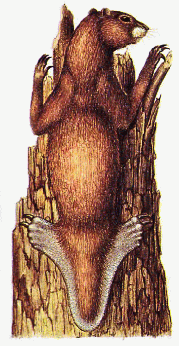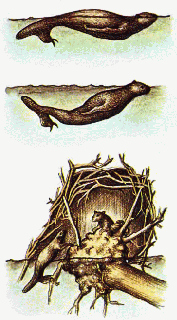
The combined rear limbs and tail of the modern beaver form an ideal structure for gripping a pine tree's rough bark.
The beaver, Castor spp., is now a newly evolved Posthomic form from coniferous forests in Europe, Asia and North America, similar in shape to pinnipeds, from After Man: A Zoology of the Future.
One large rodent that became adapted to a semiaquatic way of life during the Miocene, partly as a defense against predators, was the beaver. After humans went extinct, the beaver became even better adapted to life in water. Its tail and hind feet have become fused together into one large paddle, which, when powered by its backbone, produces a powerful up-and-down swimming stroke. Its ears, eyes and nose are placed high up on its head and remain above water when the rest of the animal is submerged. Surprisingly the paddle does not impair the creature's movement on land and is used as a grasping limb, enabling it to climb partway up trees, increasing its potential supply of food and building materials.

The modern beaver's swimming stroke involves the whole body. Its family lodge, complete with an underwater entrance, is built of sticks plastered with mud.
